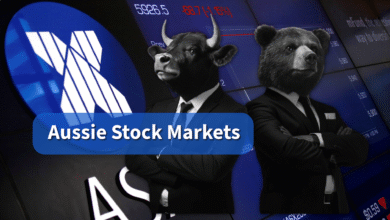Stock of The Week – ASML
ASML Holding (ASML.NL) shares faced significant pressure following its first-quarter earnings report, as the world’s dominant lithography equipment supplier navigates increasing uncertainty from U.S. tariff policies. The company’s quarterly bookings of €3.94 billion fell well short of analyst expectations of €4.82 billion, highlighting concerns about future demand amid growing trade tensions between the U.S. and China.
Earnings Miss Expectations
ASML’s Q1 performance painted a mixed picture, with net sales of €7.74 billion narrowly missing analyst expectations of €7.8 billion. While the company managed to outperform on profitability with net income of €2.36 billion exceeding the forecasted €2.3 billion, the concerning miss on bookings overshadowed these results. The weak order intake—indicating customer hesitation to commit to future equipment purchases—has raised concerns about ASML’s growth trajectory. Adding to investor unease, the company’s Q2 revenue guidance of €7.2-7.7 billion fell short of consensus estimates of €7.8 billion, with management explicitly citing tariff uncertainty as the reason for the wider-than-usual guidance range. Despite these near-term challenges, ASML maintained its full-year 2025 outlook, though executives acknowledged the company may trend toward the lower end of its €30-35 billion revenue guidance range if customer uncertainty persists.
Earnings vs Estimates. Source: Bloomberg L.P.
Tariff Uncertainty Creates Market Headwinds
ASML CEO Christophe Fouquet acknowledged that “recent tariff announcements have increased uncertainty in the macro environment,” creating a complex situation for the semiconductor equipment giant. The company finds itself caught in a contradictory U.S. policy environment where the government simultaneously encourages domestic chip manufacturing while threatening tariffs on critical manufacturing equipment. CFO Roger Dassen highlighted this inconsistency during the earnings call, noting “this complexity is being recognized” by the Trump administration, which has announced a review of the semiconductor ecosystem. Despite temporary exemptions for semiconductor equipment, ASML faces potential risks from tariffs on component materials and cross-border shipments of parts and tools needed for its complex manufacturing process.
Maintaining European Manufacturing
Despite mounting pressure from tariff concerns, ASML has firmly rejected the idea of shifting more production to the U.S. “Most of the final assembly of what we do happens here in the Netherlands,” Dassen stated, emphasizing that the company plans to maintain its European manufacturing base where its capabilities and supply chain are concentrated. Instead, ASML indicated it would likely pass a “significant part” of any tariffs onto customers, arguing that the financial burden should be distributed fairly across the semiconductor value chain, particularly to those importing machines into the U.S.
AI Demand Remains Growth Driver
Despite near-term uncertainties, ASML maintained its full-year revenue guidance of €30-35 billion, supported by continued strong demand for AI-related chipmaking equipment. “Artificial intelligence continues to be the primary growth driver in our industry,” Fouquet stated, reaffirming that conversations with customers support expectations for growth in both 2025 and 2026. The company successfully shipped its fifth High NA system in Q1, placing these advanced machines with three different customers, a critical milestone for the next generation of semiconductor manufacturing. However, the company acknowledged that AI has created “a shift in market dynamics that benefits some customers more than others,” contributing to both upside potential and downside risks.
China Exposure
China represented 27% of ASML’s net system sales in Q1, making it the company’s second-largest market despite ongoing export restrictions. While this matches China’s contribution from the previous quarter, it marks a significant drop from the 2024 average of 41%. The Dutch company continues to face U.S.-led restrictions on selling its most advanced EUV machines to China, and is now prohibited from exporting its second-most sophisticated DUV systems as well. Nevertheless, ASML confirmed that “China demand is still strong,” particularly for older equipment used to manufacture mature types of semiconductors, and expects the country to account for slightly over 25% of net system sales this year.
Valuation
At a current price ASML (ASML.NL) demonstrates premium valuation metrics compared to industry peers in the semiconductor equipment sector. ASML trades at a P/E of 23.45 versus a peer mean of 19.46, and a forward P/E of 20.52 compared to the peer average of 16.69, reflecting the market’s strong confidence in ASML’s market position and growth prospects.
Comparative Valuation
ASML shows consistently premium positioning across multiple valuation metrics when compared to peers (Applied Materials, KLA Corp, and LAM Research):
- Above mean on P/E (23.45 vs 19.46 peer mean)
- Higher forward P/E (20.52 vs 16.69 peer mean)
- Slightly below mean on P/BV (12.72 vs 13.11 peer mean)
- Above mean on P/S (7.24 vs 5.76 peer mean)
- Above mean on forward P/S (6.80 vs 5.20 peer mean)
- Slightly below mean on P/FCF (21.19 vs 21.92 peer mean)
These premium multiples reflect ASML’s dominant position in EUV lithography technology, which represents a critical bottleneck in advanced semiconductor manufacturing.
Multiple-Based Valuation
Multiple-based valuation approaches suggest mixed signals regarding ASML’s current pricing:
- Mean-based valuations indicate potential prices from €431.74 to €584.77
- Median-based models suggest €384.02 to €558.09
- Cap-weighted approaches point to €421.51 to €577.97
P/BV and P/FCF methodologies suggest the greatest upside potential, while forward P/S indicates the most conservative valuation.
Source: Bloomberg Finance LP, XTB Research
DCF Valuation Sensitivities
Our terminal WACC analysis demonstrates ASML appears fairly valued under specific growth and profitability assumptions:
- Terminal Revenue Growth Sensitivity:
- At 3.3-3.5% terminal revenue growth with a 10.0-10.4% WACC, fair value ranges between €452.02-€473.26
- More optimistic scenarios with 3.7-4.1% growth suggest valuations of €484.89-€553.76
- Operating Margin Analysis:
- Current price of €576.60 aligns with scenarios combining 35-37% operating margins with 13-15% revenue growth
- At a base case of 34% operating margin, ASML would require ~12% revenue growth to justify current market price
Source: Bloomberg Finance LP, XTB Research
Source: Bloomberg Finance LP, XTB Research
ASML (D1 Interval)
The stock is currently trading within the consolidation channel it remained in throughout 2023. Bulls may aim for a swift breakout above the 23.6% Fibonacci retracement level, while bears will likely look to retest this year’s low. The RSI is in a long-term bearish divergence, which could be broken if a higher high is achieved — a similar scenario applies to the MACD.

The material on this page does not constitute financial advice and does not take into account your level of understanding, investment objectives, financial situation or any other specific needs. All information provided, including opinions, market research, mathematical results and technical analyzes published on the Website or transmitted To you by other means, it is provided for information purposes only and should in no way be construed as an offer or solicitation for a transaction in any financial instrument, nor should the information provided be construed as advice of a legal or financial nature on which any investment decisions you make should be based exclusively To your level of understanding, investment objectives, financial situation, or other specific needs, any decision to act on the information published on the Website or sent to you by other means is entirely at your own risk if you In doubt or unsure about your understanding of a particular product, instrument, service or transaction, you should seek professional or legal advice before trading. Investing in CFDs carries a high level of risk, as they are leveraged products and have small movements Often the market can result in much larger movements in the value of your investment, and this can work against you or in your favor. Please ensure you fully understand the risks involved, taking into account investments objectives and level of experience, before trading and, if necessary, seek independent advice.






